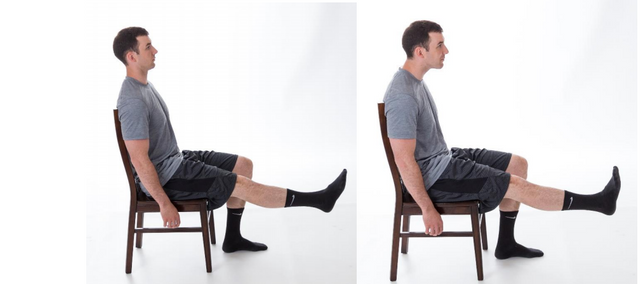Do You Have Sciatica? (Self-Tests)
Do You Have Sciatica? (Self-Tests)
We highly recommend you see your physician in order to ensure a correct diagnosis. Sciatica can be a serious disabling condition and it important that you are not misdiagnosed.
However, we do provide four self-tests you can perform. These tests can help increase your sciatica knowledge before meeting with your health care provider.
Test One (Herniated or Bulging Disc)
The first test is conducted with a seated straight leg raise in order to identify a possible herniated or bulging disc. In a seated position, lift your right leg while keeping your knee straight. While your leg is in the air, bend your right foot toward you while simultaneously flexing your neck. If you have a herniated disc, oftentimes you will feel increased pain or symptoms down the leg with this test. Now repeat the above steps with your left leg.

Test Two (Herniated or Bulging Disc)
This test is also used to identify a herniated or bulging disc. For this test, sit in a chair without any arms. Grab the underside of the chair with both arms and pull up. Next, slouch forward and extend your neck back. Be sure to note any pain occurring in your back and leg(s). Now flex your neck forward, while still being in a slouched position and pulling up on the underside of the chair. If your pain increases while flexing your neck forward, it is likely caused by a herniated or bulging disc.
.png)
Test Three (3-Part Test for Spinal Stenosis)
A. Sit in a chair with your feet on the floor and legs slightly apart. Lean forward in the chair and reach for the floor with your hands. If your backpain increases with this maneuver, stop immediately. If your back pain stops after performing this, you may have spinal stenosis.
.png)
B. Stand up from the chair and raise your arms overhead and lean back (see photo). If standing and leaning back increases your pain, you may have spinal stenosis.
.png)
C. Answer these three questions:
a. Do you have increased pain following prolonged walking and standing?
b. Does the pain stop when you are sitting or while leaning forward on a shopping cart?
c. Are you older than 55?
If you answer “yes” to all three questions, you may have spinal stenosis. Arthritis
or degeneration of the spine can cause spinal stenosis.
Test Four (Piriformis Syndrome)
This is a test to identify if you have piriformis syndrome. For this test, sit in a chair with your back upright and your feet resting on the ground. Next, place the ankle of your affected (painful) leg on the unaffected knee. Place one hand on the ankle of the affected leg. Place your other hand on the outside of the knee of the affected leg.
.png)
Next, bend forward from the waist to feel a stretch in your buttocks. At the same time, pull your affected knee toward your chest.
.png)
Increased pain and tenderness in the buttock and leg during this test may indicate the piriformis muscle is involved. If it appears that you have piriformis syndrome or spinal stenosis, confirm this diagnosis with your doctor or health care provider.
PLEASE NOTE: THIS VIDEO PROGRAM WILL NOT HELP YOU IF YOU HAVE PIRIFORMIS SYNDROME OR SPINAL STENOSIS.
This video is a part of a series of videos on how to treat Sciatica/Back Pain on your own. Check out the full series of videos along with downloadable guide sheets for each video on our website here: http://bobandbrad.com/programs